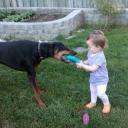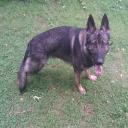Yahoo Answers is shutting down on May 4th, 2021 (Eastern Time) and beginning April 20th, 2021 (Eastern Time) the Yahoo Answers website will be in read-only mode. There will be no changes to other Yahoo properties or services, or your Yahoo account. You can find more information about the Yahoo Answers shutdown and how to download your data on this help page.
Trending News
"Proofing" your dog - what does this mean to you?
Expanding on some of the training questions...
I would like someone to define "proofing" your dog, and what techniques you use.
I have an idea of what it all means, but I have always been a little confused as to a concrete definition or technique. Hence why no one has ever heard me talk about proofing a dog lol.
I'm hoping to get some of our training experts (Curtis, Greek, Dutch) in on this!
So, what is proofing?
Expertise - would you mind expanding a little further? How do you ensure your dog is "proofed"? Do you just simply have your dog listen to your commands while providing distractions?
12 Answers
- 1 decade agoFavorite Answer
"Proofing" is basically providing the dog with the opportunity to make the decision to listen to you, or to be distracted. It helps him to more fully understand what is expected, by showing him what NOT to do.
For example, you want to proof a sit/stay. You can start out very easy, simply by moving around, since in the beginning any movement on your part is an invitation for the dog to move. When the dog moves, you correct him. NOTE: "Correction" can range anywhere from a simple "AH!" and placing the dog back into position, to a full-on leash correction, to even a zap from an e-collar (if that's how you like to train) depending on the trainer, on what stage the dog is at, and on what the dog needs and can handle. Once the dog will reliably stay no matter where you go, you can try more exaggerated movements, words, bouncing a ball, throwing the ball, playing with another dog etc. - anything that might tempt the dog to break position. You gradually increase the strength of the distractions until any distraction is simply regarded by the dog as a setup - nothing will get him to move out of position until released. One place where I used to train had a resident cat, he loved to come out and wander the floor while the dogs were doing their stays.
- 5 years ago
Find what motivates your dog. Some dogs do anything for food. Some dogs do anything for Toys. Some do anything for a good petting. Some do anything for only one type of food, like cheese, or hotdog. Some only have interest in training for 5 minutes at a time, and others can go for an hour. Figure out what your dog is willing to work for, and then work with her in sessions that are no longer than she can tolerate. How to train your dog properly https://tr.im/fPf5r
Sign up for a dog obedience training class. It will not train your dog. It will give you training on how you can train your dog. Most people understand the idea of training, but there is a right and a wrong way to do it, and there is good and bad technique. Timing and consistency is very important, and it helps to have feedback of someone watching you who can help you improve your technique to get more efficient results with your dog.
However, she may be somewhat anxious around other dogs, sort of like the shy kid on the playground. She will benefit from continuing what you are doing as far as asking her to sit before entering, but there are more things along those lines that will help her to calmly go in and out of the dog park. She may also benefit from going in short bursts, or only when fewer dogs are present, or avoiding times when other dogs that make her nervous are present. Maybe she just plays loud - my brother's dog is this way - or maybe she is a dogpark bully - sorry it is possible. But more likely she is just a little anxious around new dogs and she wants to play but just doesn't quite know how to do that and still feel comfortable. Don't be surprised if your dog does not actually like the dog park, and maybe she would get more enjoyment and less stress out of simply going for a good walk somewhere else.
A wagging tail does not mean that your dog is happy or even comfortable with the situation. It means your dog is emotionally aroused. This could be a happy arousal, or it could be a nervous arousal, or it could be an aggressive arousal. Go youtube it, there are plenty of videos of 'vicious' dogs who are throwing a very aggressive fit of barking and snarling while their tail is wagging vigorously. Even police dogs who are not let off the leash to chase down a suspect can be lunging and barking and snarling, and their tails are still going.
- VoelvenLv 71 decade ago
Proofing is basically training your dog to obey regardless of what is going on around it.
Concrete technique: Once the dog knows what you want from it and recognizes your cue, you start training this is varying environments, ensuring that the dog is performing reliably in one environment before increasing the level of difficulty by training in another environment.
The order of environment training could for example be:
- in your living room
- in your garden
- on the street
- in the city
- in the park
- at dog training classes
- among playing dogs
- on a field filled with small game wildlife
etc.
The exact order is all about knowing your dog. For some dogs, other dogs will be the highest distraction, for others it's a running hare, cats, people, loud noises, cars and so on and so on.
Proofing is also teaching your dog to respond to a cue regardless of your position whether you're standing up, lying down, having your back to it or doing a hand stand.
How to train the proofing is another matter. I prefer to increase distraction levels so gradually that I have little problem getting my dog's attention, so that I'm setting her up for a 90% guaranteed success. I will correct, but usually only with a "no". If I cannot get her attention or if I find myself correcting her several times, then I know I've gone forward too fast.
Other trainers use more aversion based methods to proof their dog, which I believe in general works faster than the method I'm using, but it's just not a method for me.
- How do you think about the answers? You can sign in to vote the answer.
- 1 decade ago
Proofing is training a dog to the standard where it immediately obeys a command, first time, every time, regardless of environmental distractions.
To achieve that you would typically need to use some form of compulsion training geared to the individual dog’s temperament. Proofing would ensure a high prey dog would break off from pursuing a rabbit which is instinct driven behavior & very satisfying, *not* to please its trainer, but because it instinctively feared the negative consequence of a correction more.
- KoAussieLv 71 decade ago
I proof my dogs in real life situations, providing distractions that they may encounter so that I can correct them at the moment of failure.
Some of the distractions I may set up while my dog is given a command would include loud noises, food in the area, children or other animals nearby, sudden and unexpected movements. If the dog breaks, I can step in and give a correction and reset the dog. I also proof in different environments, not just in a class. I train on dirt, pavement, grassy areas where there have been picnics or stock grazing, as well as on rubber mats.
I hear too many competitors complain because their dog broke when something unexpected occurred outside their ring, but in the end, the failure was theirs.
- Pack LeaderLv 51 decade ago
So far the other answerer's are doing a great job in telling *what* proofing is, so I won't go into that. I proof my dogs by throwing food, other people near by, other dogs, and cats. I don't use toys at all since neither of my two dogs are motivated in the least by toys. Me throwing grass near them would interest them more. If the dog makes a mistake I will either give a firm "hey" or I will give a leash correction.
- Anonymous1 decade ago
To train the dog to such a level that they will listen to you and follow commands no matter what kind of distractions are placed in their way.
For instance, teaching a dog to stay is one thing.. teaching a dog to stay when he is sitting two feet away from a lump of meat is quite another..
A dog that is 'proofed' is a dog who will follow commands and not deviate from a command regardless of what is going on around them.
- 1 decade ago
Proofing = Working with distractions and correcting the dog for "falling" for the bait of distraction. That way when you get on the street, or in combat, and mortar shells, bullets and so forth and so on go off, the dog doesn't decide to break it's down stay and get incinerated/shot/killed/mayhem/DESTRUCTION.
WTF it won't spell out destruction!?!?!
- LorraineLv 71 decade ago
I would of said the explanation is exactly as expertise has said.
Also using a lead to pull dog from position and still expect it to stay.










